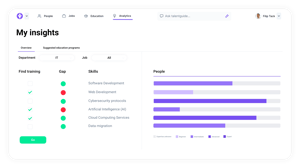The Role of AI in Managing Workforces
The article "Algorithmic Management: The Role of AI in Managing Workforces" (MIT Sloan) sheds light on the increasing use of artificial intelligence (AI) in managing workforces. The article argues that AI can bring efficiency and effectiveness to workforce management, but only if it is implemented in a way that emphasises the central role of the human person. The article highlights the need for companies to be intentional about how they use AI to manage their workforces and to ensure that they do not turn their employees into machines.
The use of AI in workforce management has become increasingly popular in recent years. The shortage on the labour market has ignited a race for automation, algorithmic management and robotisation in companies. Companies are using AI algorithms to automate various aspects of workforce management, such as scheduling, task assignment, and performance evaluation, job crafting. The idea is that AI can bring efficiency and help handle the shortage of workers.
However, the article argues that the implementation of AI in workforce management must be done carefully to ensure that it does not dehumanise the workplace.
One of the key points made by the article is that the implementation of AI in workforce management must be guided by a human-centered approach. This means that the human person should be at the center of the design and implementation of AI algorithms. The article argues that companies should not use AI simply to automate tasks and reduce costs. Instead, they should use AI to augment the abilities of their employees and to create more fulfilling roles for them. This approach recognises that humans have unique abilities that cannot be replicated by machines and that AI should be used to enhance rather than replace these abilities.
The article also highlights the importance of transparency in the use of AI in workforce management. Employees should be informed about how AI algorithms are being used to manage them and how these algorithms are making decisions that affect their work. This transparency will help to build trust between employees and management and will ensure that employees feel comfortable with the use of AI in their workplace.
Another key point made by the article is that the use of AI in workforce management should be based on data and evidence. Companies should collect data on the performance of their employees and use this data to inform the development of AI algorithms. This data-driven approach will ensure that AI algorithms are based on objective evidence rather than subjective opinions or biases. It will also help to ensure that AI algorithms are effective and efficient in managing the workforce.
Finally, the article emphasises the importance of ongoing evaluation and improvement of AI algorithms in workforce management. Companies should regularly review the performance of their AI algorithms and make adjustments as necessary. This will help to ensure that the algorithms are meeting the needs of the company and its employees and that they are not causing unintended consequences.
In conclusion, the article "Algorithmic Management": The Role of AI in Managing Workforces" highlights the need for a human-centered approach to the use of AI in workforce management. It argues that AI should be used to enhance the abilities of employees and to create more fulfilling roles for them, rather than simply to automate tasks and reduce costs. Companies should also be transparent in the use of AI, data-driven in their approach, and should regularly evaluate and improve their AI algorithms.
By following these principles, companies can use AI ensuring that the human person remains at the center of the workplace. And this is where talentguide come in. Using AI technology, we have developed the talentguide™ Library, an extensive database that links skills and activities to specific jobs, employees, and training programs within a company. The Library is continuously improved through machine learning and is tested against evolving industry standards.
With this solution, HR management can easily manage the internal job market and make informed decisions about hiring, developing, and retaining talent. With talentguide, you have control over the future of your workforce and can quickly create an agile and resilient workplace - promoting a proactive talent policy for both white-collar and blue-collar workers.





